|
|
Throughout Northwest Lower Michigan, small neighborhood businesses are interspersed among homes in older neighborhoods and at important crossroads in rural areas. These establishments supply convenience goods (e.g., groceries, household products) and personal services (e.g., dry cleaning, hair care, banking) to residents of the surrounding neighborhood. Whether businesses are located in urbanized areas where residents can walk or in rural areas where greater distances may require biking or driving, the primary clientele of Neighborhood Centers are nearby residents. The Neighborhood Center’s smaller scale typically allows it to fit into an existing neighborhood more inconspicuously than larger-scale retail establishments. Commercial establishments can also provide interest and focal points to predominantly residential or rural streetscapes. Whether a freestanding corner store (e.g., Deering’s Market in Traverse City, N.J.’s in Lake Leelanau, Francisco’s Market and Deli on Silver Lake Road, Fieldstone Market and Deli on Long Lake Road) or part of a commercial complex (e.g., Old Towne and West Front Market in Traverse City), Neighborhood Centers are valuable assets to both local and regional economies.
|
|
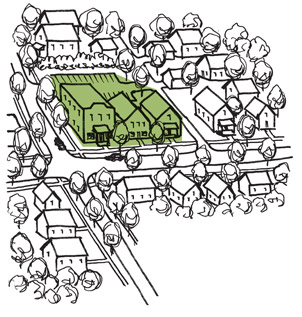
|
   |
Creating New Neighborhood Centers
Neighborhood services can enhance established areas by locating buildings on available, under-utilized land, currently undeveloped land adjacent to the established community, or within Planned Unit Developments (PUD). Local businesses that residents can access by foot or bike contribute to less traffic throughout the region. Local jurisdictions are encouraged to revise their local ordinances to allow for the creation of appropriately-scaled commercial uses within residential areas. Refer to Mixed-Use Developments for additional information.
|
  |
Adaptive Reuse of Neighborhood Centers
Land uses change over time and the existing built environment can be adapted to accommodate these changes. Train depots can be converted into office space and former grocery stores can become spas. The adaptive reuse of structures helps revitalize neighborhood character through economic and community renewal. Additionally, changes in use offer local jurisdictions the opportunity to request design improvements. Form-based coding can be employed to improve a community’s appearance and function over time. Refer to Critical Design Practices: Redevelopment of Existing Properties, Building Revitalization & Reuse, and Building Design & Materials for additional information. |
|
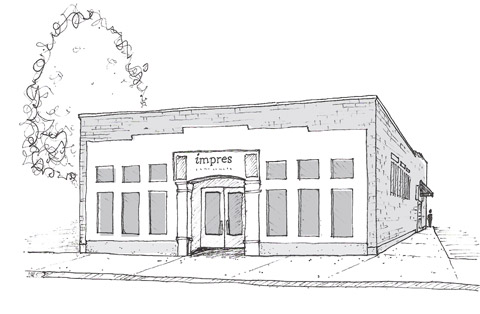
|
When Designing Neighborhood Centers:
• Conduct site assessment
• Locate buildings to retain desirable existing vegetation and other natural features
• Incorporate architectural elements to complement community character
• Design parking areas to facilitate safe and efficient access
• Establish pedestrian pathways connecting building entrances and parking areas
• Place parking lots behind or beside buildings
• Screen parking areas, especially those between buildings and roadways
• Encourage shared parking and reduced parking standards
• Design landscaped islands to break up the mass of parking areas
• Promote alternative surfacing materials
• Combine and screen service elements
• Use low-maintenance landscaping
• Control and recycle stormwater runoff
• Incorporate context-appropriate signage
• Assess trash and recycling service needs |
 |
|
Designing Neighborhood Businesses
When appropriately designed, neighborhood businesses can enhance local and regional character and be integrated into predominantly residential areas within the ten-county region. By incorporating aesthetically pleasing architectural and site elements of nearby structures, a new or renovated building’s design can complement an existing neighborhood (i.e., architecture similar to older buildings in a historic neighborhood or similar to newer buildings in a new development). Form-based coding provides communities a method of determining a building’s architectural character while accommodating changing uses over time. Regardless of the location, neighborhood sensitive site and building design are essential to accommodating a neighborhood business’s needs with minimal disruption to surrounding properties.
While guidelines can facilitate integration of new businesses into an existing neighborhood, they are equally useful for remodeling existing establishments. Design of Neighborhood Centers includes the following elements: building design and orientation, pedestrian access, vehicular access and parking, signage, lighting, landscaping, buffering and screening, and mixed uses. For detailed information on specific techniques, refer to the Critical Design Practices section.
|
|
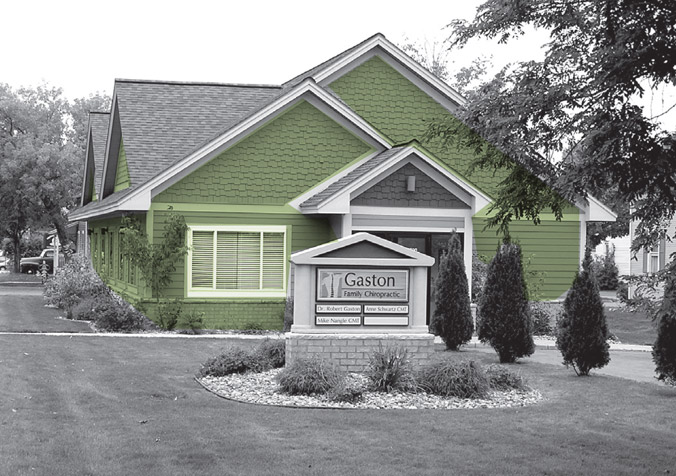
|
|
Landscaping
Preserving desirable existing vegetation and landscaping with native plants can enhance regional character and reduce maintenance costs, as well as augment the appearance and integration of buildings, drives, and parking areas. Attractive landscaping, site furniture, and lighting in courtyard and entry areas can enhance the aesthetic appeal of a Neighborhood Center. Screening and buffering incompatible land uses and blank walls with a mixture of trees and shrubs also adds to a development’s attractiveness. Refer to Critical Design Practices: Landscaping and Streetscape for additional information.
|
|
|
Building Design & Orientation
Neighborhood businesses should be located near and oriented towards streets and sidewalks. Buildings should encourage and accommodate window shopping, heavy foot traffic in and out of stores, and people-watching from outdoor seating areas. Incorporating visual and architectural elements (e.g., large windows, awnings, signage) in their design enhances the pedestrian streetscape. Design and materials that reflect the character of the area and nearby structures improve compatibility and integration of new buildings into established communities. When presented with renovation projects, local jurisdictions should encourage rebuilding in a traditional pattern such as buildings close to streets and sidewalks, with parking behind. Refer to Critical Design Practices: Building Orientation, Building Compatibility, and Building Design & Materials for additional information.
|
|
|
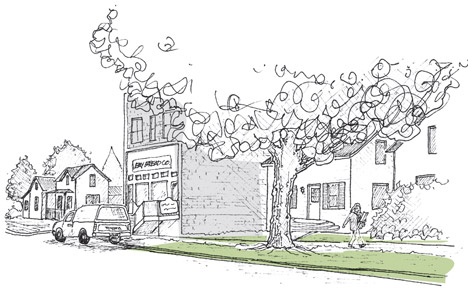
|
|
Mixed Uses
Multiple-story neighborhood commercial buildings offer the opportunity to mix uses either through additional businesses or residences on upper floors. Mixed-use structures can add to a neighborhood’s vitality by generating activity throughout the day and evening. Separate entrances and other design elements can help ensure the privacy and security of residential units. Some of the options for mixed uses include:
Retail on ground level with housing above
Retail on ground level with offices above
Retail on ground level with parking above
Retail on ground level with parking below
Local jurisdictions can promote a mixture of uses by allowing an additional story for residential use (e.g., first floor retail, second floor office, third floor residential). Refer to Mixed-Use Developments for additional information.
|
|
|
Entries & Pedestrian Access
Primary entrances to Neighborhood Centers should be from the main street with secondary entries from adjacent parking areas located behind or beside the building(s). Architectural details and landscaping elements create identifiable, inviting, and accessible entrances. Since Neighborhood Centers primarily serve residents of surrounding neighborhoods, sidewalks should encourage pedestrian access, and bike parking areas should be provided whenever possible. Barrier-free considerations must be incorporated into the design of access ways and entrances. Refer to Critical Design Practices: Site Access, Building Design & Materials, and Landscaping for additional information.
|
|
|
Parking
The smaller scale of neighborhood centers typically equate to smaller parking needs. On-street parking facilitates access to neighborhood businesses, while replacing or minimizing the need for parking lots. It also stimulates streetside activity. Parking lots may be shared by adjacent businesses, further reducing the amount of impervious surfaces. Locating small parking areas behind or beside buildings and accessing them from alleys and side streets contributes to the attractiveness of the streetscape. Parking lots should be screened to minimize their impact on adjacent properties while maintaining safe access. Refer to Critical Design Practices: Parking and Building Orientation for additional information.
|
|
|

|
|
Serivce Elements
Service elements (e.g., recycling, dumpsters, loading areas) should be located and screened to minimize their impact on adjacent properties. Refer to Critical Design Practices: Service Elements for additional information.
|
|
|
Service Vehicle Access
A Neighborhood Center’s site design should facilitate delivery and service vehicle access with minimal impact on adjacent properties. Incorporate side or rear access whenever possible. Refer to Critical Design Practices: Site Access and Parking for additional information.
|
|
|
Lighting
Exterior lighting should be designed and scaled to address safety concerns without disturbing adjacent properties or contributing to light pollution. Installing timed and/or motion triggered lights around the side and rear of buildings ensures that lights are on only when needed. Refer to Critical Design Practices: Site Lighting & Utilities and Streetscape for additional information.
|
|
|
Stormwater Control & Dentention
Opportunities for control of on-site stormwater in Neighborhood Centers include minimizing the impervious service area by reducing the size of parking lots and/or using porous paving, landscaped rain gardens or other infiltration methods, or capturing rain water for reuse. Refer to Critical Design Practices: Stormwater Control & Detention for additional information.
|
|
|

Residences converted to businesses, Traverse City, Grand Traverse County
|
|
Access & Circulation
The design of Neighborhood Centers should provide safe, easy access for pedestrians, bicycles, and automobiles. Refer to Critical Design Practices: Site Access for additional information.
|
|
|
Signage
A Neighborhood Center’s sign design should reflect the architectural style and materials of a building, as well as the character of the neighborhood. Local jurisdictions may consider varying sign size standards depending on location: in more urbanized areas, signage should be pedestrianscaled (i.e., small, simple, easily readable by passersby at slower speeds) while in more rural areas, signs may need to be slightly larger to be visible from passing automobiles. Refer to Critical Design Practices: Sign Design & Placement for additional information.
|
|
|
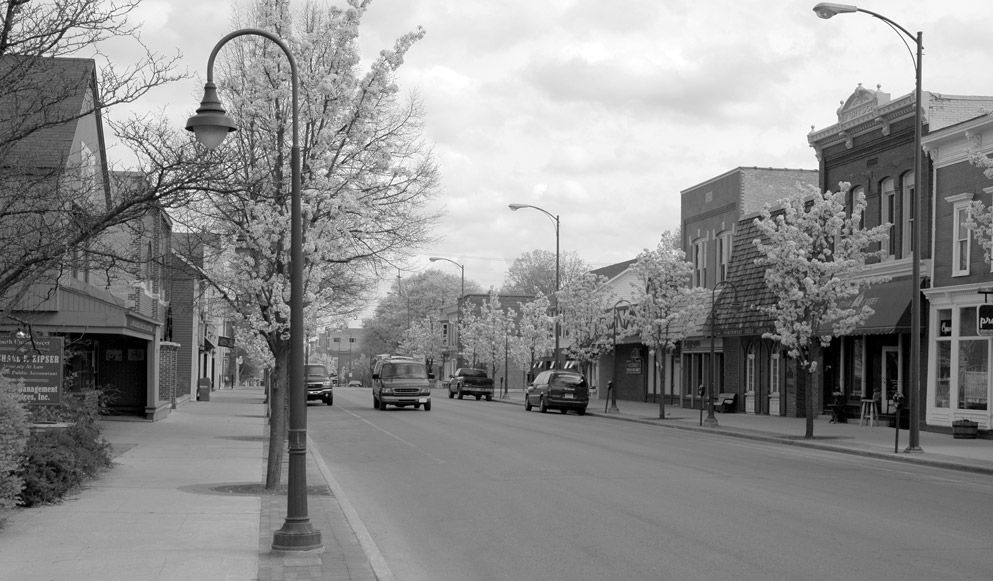
Old Towne, Traverse City, Grand Traverse County
|
|
Streetscape
Streetscape elements (e.g., street trees, benches, special paving) highlight and bring attention to commercial establishments while enhancing the neighborhood. Clusters of shops have an opportunity to coordinate the design and implementation of streetscape elements to increase their curb appeal and usability. Refer to Critical Design Practices: Streetscape for additional information.
|
|
|
